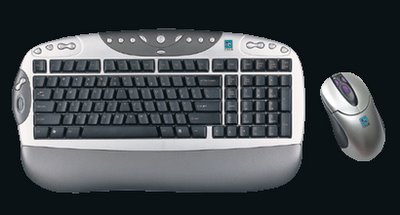Dvorak keyboards
This post was originally published at sinewalker.blogspot.com.au on 27 March 2006.
I prefer Dvorak keyboards to QWERTY, which confounds my work colleagues no end :-)
I've been typing on Dvorak for about 3 years now [ed: That is, since 2003]. The main reason I use the Dvorak keyboard layout is because, after 15 years of six-finger typing on QWERTY, I decided to learn to touch-type, and Dvorak is very easy to learn (I learnt it in 2 weeks, back to my old typing speed after a month).
I don't believe Dvorak makes me a faster typist inherently (though I am faster now that I can touch-type), but it's much more comfortable and the shooting pains in my arms have gone.
 At home, I use a slightly older model of the A4 KB(S)-2350ZRP (pictured). I chose this keyboard over more radical designs that I like, because the A4 2350 is not too different from a standard typewriter layout — so it plays nice with other people in the family. The A-shaped keys help a lot with my lower-arm pains too, but not so much as the Dvorak layout, since most of the time I'm typing at work on a standard Dell SK-8125.
At home, I use a slightly older model of the A4 KB(S)-2350ZRP (pictured). I chose this keyboard over more radical designs that I like, because the A4 2350 is not too different from a standard typewriter layout — so it plays nice with other people in the family. The A-shaped keys help a lot with my lower-arm pains too, but not so much as the Dvorak layout, since most of the time I'm typing at work on a standard Dell SK-8125.
Making up strong passwords with this keyboard layout is much easier now. Think of a fairly good password (fee1bo7ch, for instance) and then type it on Dvorak as-if you were typing on QWERTY (becomes u..1xr7jd).
I'm thinking about teaching my left hand to type one-handed dvorak too, to improve my mousing experience.
Issues I've encountered with Dvorak
There are some minor annoyances when you switch away from QWERTY. Anybody in a minority group (such as left-handed people) will identify with some of these. None of these issues have been serious enough to cause me to switch back to QWERTY though, as the benefits I've gained (typing speed, no more pain) far outweigh any of them, even all considered together.
- Typing on someone else's QWERTY keyboard becomes very uncomfortable. I frequently shudder at the thought of having to touch someone's keyboard now (not because of hygiene, but it's the same feeling). I can still do it, and since I never learnt to type properly on QWERTY anyway, it's no trouble to look at the keyboard. Years of familiarity with this layout means I don't need much reminding, so it's not like I have to hunt for keys, more like a mental changing of gears and putting up with awkward key combinations (like, for instance A-W-K-W-A-R-D)
- In the same vein, letting someone else use your keyboard can be fun! Most operating systems allow an easy/quick way to switch layouts. Windows sort-of does, but it only applies to the current window, not the whole system (what a stupid design!), so you need to remember that gotcha. I sometimes use this as an opportunity to advocate Dvorak, but usually this is interpreted as “just Mike evangelising again…” ;-)
- Some programs and games make expect the QWERTY layout in selecting keyboard short-cuts. For example, vi uses the H J K and L keys for cursor movement, since this arrangement is sensible in QWERTY. On Dvorak, it's useless as those keys are located at the J C V and P positions. But then again, vi sucks anyway, so it's not a problem. Winamp uses Z X C V and B for pause, playback and track selection functions, but it can be re-programmed, at least for the global shortcuts. Some games suffer, so you need to switch back to QWERTY for them
- Passwords can be tricky. On systems that lock your account after too many bad tries, you have to be very confident that you know where the keys are! An alternative is to use my password trick above, and always look at the keys when entering passwords. This is accurate, but if you need to put in your password on a QWERTY keyboard, you have to know the real password, and not the easier QWERTY–Dvorak mapping you have memorised.